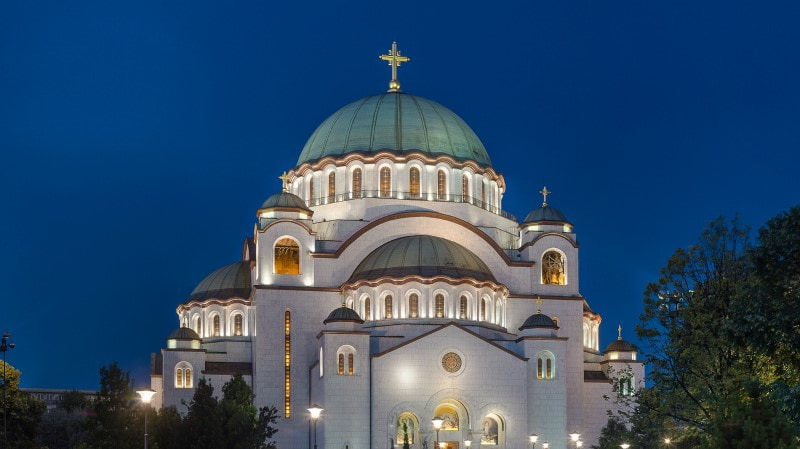|
It is disheartening to see the ongoing destruction of the monuments erected to honor our Southern forebears. There is, however, a bright ray of light shining in Serbian history that should give Dixiefolk hope for our future. The story begins several hundred years ago, with the repose of St Savva, the beloved archbishop and patron saint of Serbia: After his death in Trnovo, Bulgaria on January 14, 1235 Saint Savva was buried in the Cathedral of the Forty Martyrs. On May 6, 1237 his relics were carried in procession from Trnovo to Mileshevo Monastery in Serbia. When the casket was opened, the relics were found to be incorrupt, and produced an ineffable fragrance. In 1253, the Serbian Orthodox Church glorified the holy hierarch Savva as a Saint. Because of the intense love of the people of Serbia for their archpastor, he became a source of inspiration for the Serbs after the Muslim Turks conquered their land: Following the Battle of Kosovo on June 25, 1389, the Serbian nation fell under the Turkish Yoke. During this period the Serbs continued to visit the tomb of Saint Savva, asking him to give them the strength to endure the oppressive persecution they suffered at the hands of the Turks. His icon was placed on their flags, and the faithful turned to the Saint for encouragement, consolation, and healing. Here the parallels with Southern history begin to come into view, as Southerners, during the dark days of Lincoln’s war and in the aftermath, were often consoled, encouraged, and uplifted by the news or the presence or the recounting of the deeds of the patriarchs they loved ardently, like Lee, Forrest, and Jackson. In their efforts to quell the resistance of the Serbs, the Turks made the decision to burn the holy relics of St Savva: Following the Battle of Kosovo on June 25, 1389, the Serbian nation fell under the Turkish Yoke. During this period the Serbs continued to visit the tomb of Saint Savva, asking him to give them the strength to endure the oppressive persecution they suffered at the hands of the Turks. His icon was placed on their flags, and the faithful turned to the Saint for encouragement, consolation, and healing. Likewise, those who hate the South are attempting to undermine what remains of our yearning for independence by destroying the memorials of our heroes. Yet the Turks’ burning of St Savva’s relics did not have the desired effect: Instead of becoming despondent, the Serbs were inspired to even greater love for Christ, for Holy Orthodoxy, and for Saint Savva. Although the Saint's relics had been destroyed, the people continued to venerate him, and to remember the burning of his relics every year. Not only that, but the people of Serbia went further, and built a grand and glorious cathedral in honor of St Savva, a project that was not accomplished without difficulties: After national independence in 1879, there was a proposal to build a memorial church in honor of Saint Savva. In 1895, the three hundredth anniversary of the burning of Saint Savva's relics, plans were made to build a church on the site where his relics were burnt. A temporary chapel was constructed the following year, but it was not possible to build a large cathedral until after World War I. In 1927, Patriarch Barnabas announced a competition for architects to submit designs for the cathedral. In 1935, architects were chosen and construction began. Southerners should take heart from all of this. Yes, things look bleak right now, as the Yankees and scalawags do their best to imitate the Turks, destroying the physical monuments dedicated to our people’s great men. But there is no reason to believe that we, with God’s help, cannot be victorious in the end, rebuilding the memorials of our forebears in a more glorious form just as the Serbs did for St Savva. But we must take note: It was a long process, with several setbacks. We, and our children, and their children, and so on, must be ready to encounter and endure obstacles on the path to the restoration of our Southern ethnos. A famous saying among the Serbs grew out of the cruelty of the Turks’ burning of St Savva’s relics: ‘Sinan Pasha lit the flames, Savva's body burned, but Savva's memory and his glory did not burn.’ May it be said one day of the South, Yankee vandals with their bars and cranes Dixie’s generals and their soldiers broke and crushed, But their memory and their shining honor In their madness they did not scathe nor dent. Notes:
All quotes above come from this essay: https://www.oca.org/saints/lives/2022/04/27/100127-the-burning-of-saint-savas-relics For pictures and more details about the splendid St Savva’s Cathedral in Belgrade, Serbia, follow these links: http://www.serbia.com/church-saint-sava-orthodox-heart-belgrade/ https://en.wikipedia.org/wiki/Church_of_Saint_Sava
0 Comments
Leave a Reply. |
AuthorWalt Garlington is a chemical engineer turned writer (and, when able, a planter). He makes his home in Louisiana and is editor of the 'Confiteri: A Southern Perspective' web site. Archives
July 2024
|

